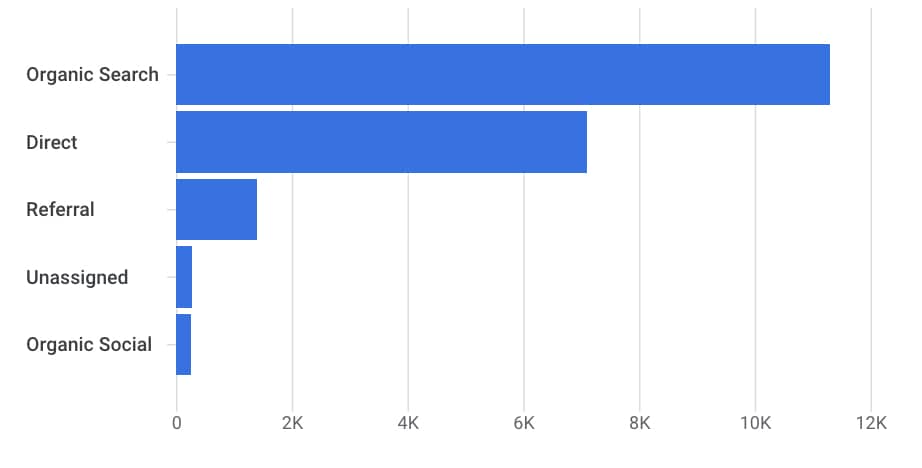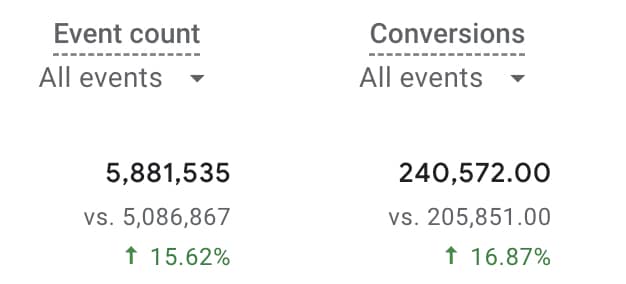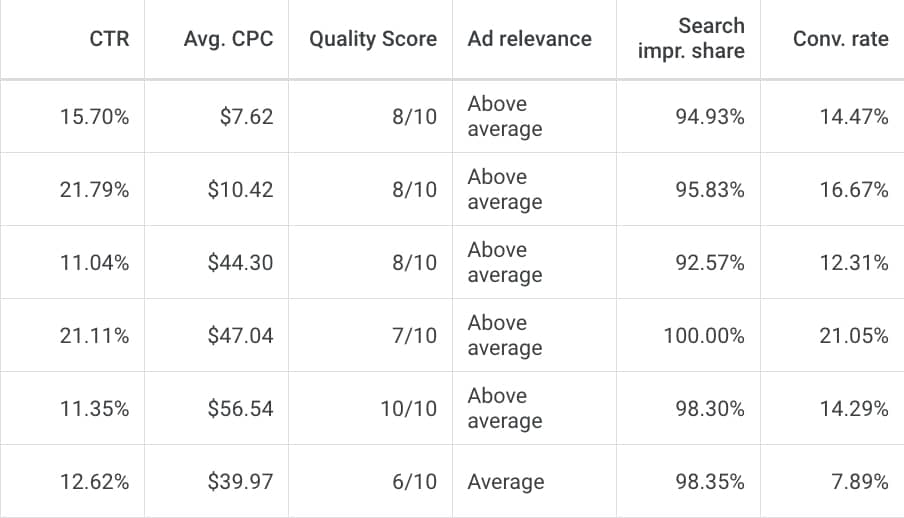Marketing Metrics: What Your Agency Isn’t Telling You Could Cost You Thousands!
14 Minute Read
Marketing metrics are a critical component of measuring marketing success. Unfortunately, agencies often fall short on reporting these metrics in one of two big ways:
- Reports are superficial and fail to define KPIs and/or attribute them correctly.
- They focus on vanity metrics, either at the client’s insistence or because the people at the agency don’t know how to prove their worth.
If your agency isn’t tracking the right metrics, you could be losing money on marketing without even knowing it. As data fanatics, we at Twelve Three Media don’t shy away from the intricacies of analytics and reporting. We view the data as a way not only for our clients to make intelligent marketing decisions, but an essential method for validating our efforts.
Why Are These Metrics Important?
Coaches and players don’t just look at the final score and feel good about themselves if they win or shake their heads in disappointment if they lose. They examine the playbook, watch game film, and take other steps to understand why and how they won or lost—and what they can do moving forward to perform better.
Nearly one-quarter of ad spending is wasted. Every marketing dollar counts, so it is critical to zero in on (a) the metrics you need to track and (b) how they measure your overall success.
It’s the same way with marketing. Tracking performance across a wide range of metrics enables you to evaluate the success or failure of your marketing and advertising, as well the return on investment.
How Do You Know If Your Marketing Is Working?
We’ve sat on a lot of reporting calls where other marketing agencies focused on nothing but fluff and magic. Our team, meanwhile, looks at the hard data so we can understand the results, report them to the client, and build on the data to obtain even greater success.
There are countless ways to market a business. As always, we strive to educate our clients and cut through the industry B.S. so businesses can demand better from their agencies. To evaluate metrics effectively, it is important to make sure your agency is focusing on the right KPIs.
Below, we focus on the metrics your agency should be reporting on for three critical marketing strategies:
Marketing Metrics for SEO
Many people think that the success of an SEO strategy is determined only by keyword rankings. Unscrupulous agencies are counting on this, which is why they try to draw your attention to keyword rankings (a vanity metric subject to constant change) rather than pointing to actual campaign results.
While ranking first in the SERPs (search engine results pages) is vitally important for the visibility of your business and driving traffic, showing up #1 on Google isn’t the end goal. In reality, topping the search results is often just the first step in converting someone who finds your products or services via online search into a lead or sale.
Lots of agencies try to distract their clients with keyword reports. Instead, the three important SEO metrics agencies should be reporting on are:
Organic Traffic
Unlike direct traffic (where the user has already been made aware of the brand, which is why they go directly to the website) or referral traffic (where another website, organization, or business is pointing the user to the website), organic traffic consists solely of the users who access your website through online search. It is the most “natural” metric to start measuring the impact of SEO.

A butcher shop might be the best in town. But if there’s no sign out front (page title tag), no indication of the shop’s offerings on the door (meta description), no meat hanging in the window (good website, quality images, etc.), and the shop isn’t clean and presentable (good user experience)—who will know about the butcher shop, let alone come inside?
Measuring organic traffic is how you go from simply monitoring the visibility of your website via keyword rankings to assessing the actual impact of SEO marketing. Check the Google organic search report in Google Analytics to see how many people visit your website from search results.
The organic traffic metric effectively serves as the “click-through rate” (CTR) for SEO marketing. It measures the number of users who click on a search result and visit your website. This is a much more effective indicator of SEO success than keyword rankings because a click signifies some form of intent—whether an intent to learn more, an intent to weigh one’s options, or an intent to buy.
Quality of Traffic
Next, you need to assess the quality of the traffic coming to your website. “Quality” refers to the likelihood of the users to take actions that align with your business goals. Just as a store wants to drive sales and avoid looky-loos, you need to make sure website visitors are doing more than just browsing.
One of the most important metrics for assessing the quality of traffic is dwell time. Dwell time refers to the length of time users spend on a particular page of your website. The longer they stay on the page, the more engaged they are.

Engagement is critical for driving search traffic. High dwell time tends to signify that the content is informative and authoritative—both critical not only for ranking high in the SERPs, but ensuring that users have what they need to make a purchase decision. If the high dwell time on the page corresponds to a high rate of conversions, this signals that your SEO and content strategy is paying off!

Conversion Rate
Finally, you need to validate the results of SEO against the actual business you earn. Instead of simply presenting data that looks good, a reputable agency will tie the conversion rate back to your actual SEO goals (namely organic traffic, clicks, and—ultimately—leads). This involves a bit of extrapolation, as most SEO tools don’t provide this kind of granular attribution.
Google Analytics 4 isn’t a perfect tool for tracking the conversion rate on SEO, but it helps. Once you have a good grasp of the organic traffic, you can check out the conversion events report. This report measures the number of conversions on your website.
A conversion is a parameter defined within Google Analytics 4, and it may encompass:
- Form fills
- Clicking a click-to-call button or link
- Video views
- Downloads
- And more
Setting up conversion events is absolutely critical for obtaining reliable data from Google Analytics 4. In addition to defining the events that matter for your business success (leads, engagement, etc.), tracking conversion events enables you to assess the conversion rate for users who arrive on your website via organic search.
Read our blog post on setting up Google Analytics 4 for more information about conversions.
Marketing Metrics for Social Media
Social media marketing is all about building relationships with current and prospective customers. The metrics our experts pay attention to when reporting on social media marketing and advertising include:
- Engagement (likes, reactions, comments, shares, saves, etc.)
- Video views
- Reach
- Impressions
- Followers
@twelve3media but we love Coors 🥺 #chefboyardee #coorslight #goldencolorado ♬ original sound – Nostalgia Tavern
Traffic from Source (Organic or Paid)
First, you need to define where the traffic is coming from. Different traffic sources have different KPIs, so it is important to separate organic engagement from the traffic you get via paid ads.
Each social media platform will have slightly different reports for organic and paid traffic. We recommend perusing the dashboard for each channel and familiarizing yourself with how each traffic source is tracked.
Quality of Traffic
When looking at the traffic from organic or paid, the next step is to determine whether the users accessing your social media pages are qualified. In other words, are they taking part in actions that benefit your marketing?
Quality organic traffic would be a high percentage of users who like, comment, or otherwise interact with your page. Meanwhile, the quality of paid social media traffic would be ascertained on the basis of each campaign. For example, if your goal is to drive leads, traffic would be considered high-quality if a significant portion of users who are served a social ad convert into leads or sales.
Engagement Rate
Many social media campaigns aim to amplify the visibility of a page (as well as the brand behind it). The engagement rate is the overall metric for determining how effective such a campaign is.
KPIs that may be assessed as part of the engagement rate for social media marketing include:
- Likes or reactions
- Comments
- Shares or reposts
- Click-through rate (i.e., the ratio of users who click on a link or call-to-action within your post compared to the total number of users who view the content)
- Mentions
- Engagements (i.e., the sum of likes, comments, shares, clicks, mentions, etc.)
- Total reach or impressions
It is important to note that engagement is defined by different actions on different social media platforms. You (or your agency) should have a robust understanding of the applicable terminology to assess the engagement rate.
Read More: Top Social Media Platforms for Your Business in 2024
Sentiment
Social media marketing is unique in both its immediacy and intimacy. There is truly no better way to get to know what current and prospective customers (not to mention the public at large) think about your business.
Multiple factors go into measuring sentiment on social media, including:
- Reviews
- Moderation of comments (i.e., the proportion of positive to negative comments)
- Social listening (i.e., what users are saying about your brand on social media)
If consumers have a negative sentiment toward your business, you may need to engage in damage control to improve your reputation and lay the groundwork for more positive social media interactions.
Response Rate
The response rate in social media marketing refers to the percentage of customer inquiries, messages, or comments that a brand responds to within a given timeframe. It is a crucial metric for measuring the effectiveness of your social media engagement and customer service.
A quick response to customer inquiries or comments is essential for building positive relationships with your audience and demonstrating your commitment to customer satisfaction. Social media platforms often display response times on business profiles, providing transparency to users about the brand’s responsiveness.
It’s worth noting that a high response rate not only improves customer satisfaction but can also positively impact algorithms on certain platforms. Social media platforms may prioritize content from accounts that are actively engaging with their audience. Therefore, monitoring and improving your response rate is a valuable aspect of social media management.
Follower Growth Rate
The follower growth rate measures the increase in your social media audience over a specific period. It is a critical metric for evaluating the success of your content in attracting new followers.
A healthy follower growth rate is often considered a positive indicator of a brand’s popularity, influence, and overall appeal on social media platforms. Such growth may also be considered a positive signal by social media platform algorithms, making it more likely that your page and posts will be seen by new and existing users alike.
Marketing Metrics for Ads
Digital advertising comes in many different forms. A robust mix of advertising campaigns can be hugely beneficial for your business, but it is important to determine where the audience is and which channels are most effective for attaining your goals. For many industries, traditional advertising is also advantageous.
Below, we discuss several of the most effective advertising channels and the metrics that are most important for gauging their success.

Pay-Per-Click (PPC) Ads
Each of the major search engines offers pay-per-click advertising. While organic SEO is something of a “slow burn” (at least for competitive keywords), PPC allows you to top the search results much faster—provided you have the budget.
Tracking is a must for PPC campaigns because you need to keep a handle on your budget. Pay attention to the following KPIs:
- Top of page: “Top of page” refers to the placement of an advertisement at the top of the SERPs (i.e., above the organic search results). Achieving a high percentage of “top of page” impressions indicates that your ad is being prominently displayed, ideally increasing visibility and click-through rates.
- Impressions share: Impressions share measures the percentage of total impressions your ads receive relative to the total number of impressions for a given keyword. A high impressions share suggests effective targeting and competitiveness, while a low impressions share may indicate missed opportunities or issues with keyword targeting and budget.
- Click-through rate (CTR): In the PPC realm, CTR is the ratio of clicks to impressions. CTR is a key indicator of how engaging and relevant your ad is to users. A higher CTR generally signifies effective ad copy and relevance, contributing to improved ad performance.
- Cost per click (CPC): CPC represents the cost paid by an advertiser for each click on their PPC ad. It is calculated by dividing the total cost of the ad campaign by the number of clicks received. CPC is essential for budgeting and cost management in PPC campaigns.
- Time on page (resulting in leads): Time on page measures the average duration users spend on a landing page after clicking on your PPC ad. Monitoring time on page helps to assess the quality of your landing page and its ability to retain and engage visitors. Longer times may indicate more effective landing pages—provided they result in significant leads.
- Ad relevance/quality score: Ad relevance or quality score is a metric used by search engines to evaluate the relevance and quality of your ads. Multiple factors are considered, including expected click-through rate, usage of the target keyword, and landing page experience. A higher quality score can result in lower costs and better ad placements. It encourages advertisers to create more relevant and valuable ads for users, ultimately improving the user experience.
- Brand lift: Brand lift measures the increase in brand awareness or perception resulting from exposure to PPC campaigns. It encompasses metrics such as brand recall, brand favorability, and purchase intent.
- Conversion rate: The conversion rate in PPC refers to the percentage of users who take a desired action—such as making a purchase, filling out a form, or signing up for a service—after clicking on an ad. Conversion rate is a critical metric, as it directly measures the effectiveness of your PPC campaigns in driving desired actions.
- Customer acquisition cost (CAC): CAC represents the average cost to acquire a new customer through PPC advertising. It is calculated by dividing the total advertising costs by the number of new customers acquired within a specific period. CAC is a vital metric for assessing the efficiency and profitability of PPC campaigns in acquiring new customers.
Successful pay-per-click advertising can be summed up by the mantra “you have to spend money to make money.” While a sizable investment is often key, that doesn’t mean you can afford to ignore the metrics that make it possible for you to spend your marketing money wisely.
That is why you also need to pay attention to the return on ad spend (ROAS) metric. ROAS measures the revenue generated from ad spend, calculated by dividing the total revenue from the ads by the total amount spent on the ads. It is a crucial indicator of how efficiently each advertising dollar contributes to lead and revenue generation for PPC and other advertising campaigns.

Video Ads
From YouTube to social media, there are a wide range of platforms for delivering video ads to consumers. Before you can launch a video advertising campaign, you will obviously need to produce high-quality videos. Then you can focus on reaching consumers through video advertising.
Important metrics for video ad campaigns include:
- View through rate (VTR): VTR measures the percentage of viewers who watched a video ad to completion or to a certain point (such as 25%, 50%, or 75%) without skipping it. It indicates the level of engagement and interest generated by the video ad.
- Click-through rate (CTR): With video ads, CTR measures the percentage of viewers who clicked on the video ad’s call to action or associated link. A high CTR indicates that the video is effective in prompting viewers to take further action.
- Conversion rate: The conversion rate measures the percentage of viewers who completed a desired action after interacting with the video ad, such as making a purchase, signing up for a newsletter, or downloading an app. It directly ties the video ad performance to actual conversions or business outcomes.
- Engagement metrics: Engagement metrics include likes, shares, comments, and social interactions associated with the video ad on social media platforms. These metrics indicate the level of audience engagement and interaction with the ad.
- View duration: View duration measures the average length of time viewers watched the video ad. It provides insights into the video ad’s ability to captivate and retain viewers’ attention.
- Cost per conversion (CPC): CPC calculates the average cost incurred to acquire a conversion (e.g., purchase, sign-up, etc.) through the video ad campaign. It helps advertisers evaluate the efficiency and profitability of their video ad spend in generating desired outcomes.
- Return on ad spend (ROAS): Producing videos and running ads can both be expensive. You need to keep a close eye on ROAS so you know what revenue is being generated from the money you spend on video ads.
By tracking and analyzing these key metrics, advertisers can assess the performance of their video ad campaigns, optimize their strategies, and allocate resources effectively to maximize their ROI from video advertising efforts.
Read More: 10 Ways to Incorporate Videos into Your Marketing
Traditional Advertising
Many different options are available for traditional advertising, including TV commercials, billboards, and more. While these strategies may be overshadowed by the plethora of digital options, they are still highly effective in specific markets and among particular audiences.
The most important metrics for measuring the success of traditional advertising depend on the type of campaign(s) you’re running. Broadly speaking, the metrics to monitor for traditional ads include:
- Response rate: The response rate measures the percentage of people who respond to a specific call to action, such as visiting a website, calling a phone number, or redeeming a coupon. It indicates the effectiveness of the ad in prompting immediate action from the audience.
- Coupon redemption rate: For print ads or direct mail campaigns that include coupons or special offers, the coupon redemption rate measures the percentage of coupons or offers that are redeemed by customers. It provides insights into the ad’s impact on driving sales or foot traffic to retail locations.
- Brand awareness and recall: Metrics for brand awareness and recall measure the audience’s ability to recall or recognize the advertised brand or product after exposure to the traditional ad. This can be assessed through surveys, focus groups, and other research methods to gauge the ad’s effectiveness in increasing brand visibility and recognition.
- Sales lift: If the goal of your advertising is to increase sales, sales lift figures can help to establish the impact of the ad.
- Website traffic and direct visits: For traditional ads that include website URLs or specific calls to action directing viewers to visit a website, monitoring website traffic and direct visits can provide insights into the ad’s effectiveness in driving online engagement and conversions.
- Customer surveys and feedback: Conducting customer surveys or gathering feedback from customers who interacted with the traditional ad can provide qualitative insights into the ad’s impact on brand perception, purchase intent, and overall customer satisfaction.
Once again, return on ad spend is a critical metric for traditional as well as digital advertising. Although traditional ads lack the dashboards where you can track metrics, advertising partners and agencies should be able to provide you with key insights.
Demand Clear, Actionable Data from Your Marketing Agency
When it comes to marketing and advertising, your end goal needs to be the bottom dollar. You should focus on driving leads and making money, not getting too granular on any one metric.
At Twelve Three Media, we work with our clients to craft custom-tailored marketing and advertising strategies. In addition to devising a robust and complementary media mix, we provide extensive reporting that enables us to optimize conversion rates and help businesses across multiple industries reach a diverse range of goals.
